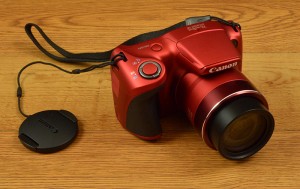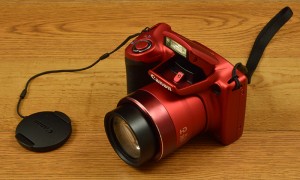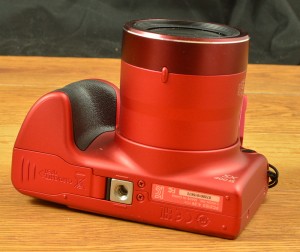Canon PowerShot SX400 IS Review
Canon PowerShot SX400 IS Review
by Jamison Cush Reads (294,037)
Overview
QUICK TAKE
A 30x optical zoom and nice design are reasons to consider the modestly-priced Canon PowerShot SX400 IS, but its horrible menu navigation scheme and bare-bones features really hurt its overall quality.
It’s the zoom. That’s the feature that point-and-shoot cameras have over smartphone cameras. Specifically, the optical zoom. Thin and light smartphones just don’t have the build for moving glass.
Sure, there are some “smart cameras” that have Android and a mobile processor on a point and shoot, and some smartphones, like the Nokia Lumia 1020 in particular, have upped the megapixel count to create an effective digital zoom. But nothing from the mobile world has come close to replicating the clarity or convenience of an automatic optical zoom.
That’s good news for Canon, which still pumps out compact and point-and-shoot cameras through its popular PowerShot lines. One of its latest, the PowerShot SX400 IS comes from the Ultra Zoom subset (as signified by “SX”), sporting a 30x optical zoom along with a 16-megapixel CCD (1/2.3-inch) sensor and DIGIC 4+ image processor.
It’s pretty bare bones otherwise, with a 3-inch TFT LCD display with 230,000 pixels and records 1280 x 720 resolution video at up to 25 frames per second. The camera lacks some modern features, though, including touch controls and wireless connectivity. At launch and as of this review, it costs $250.
Build and Design
The Canon PowerShot SX400 IS resembles a mini DSLR at a glance. That makes it far from pocketable, like many compact point-and-shoots, but it does make for a comfortable shooting experience. In fact, it’s almost hard to believe how basic and featureless the SX400 really is, given its good looks. It’s available in both red and black.
The camera also feels light for its design, and is still reasonably well constructed considering its price. It could likely survive a drop or two, but it’s not water or dust resistant, and is at the mercy of the elements.
Ergonomics and Controls
The PowerShot SX400 really is a pleasure to hold and use. The right-handed grip has an agreeable texture and is deep enough that one can easily secure the SX400 in one hand. The buttons are all located on the right side of the device and are thumb accessible, while the large shutter/focus button rests within reach of the index finger. All the buttons are large and click nicely when pressed. As is typical with most cameras, the zoom lever surrounds the shutter button, and provides enough resistance for controlled zooms.
The biggest flaw is a minor gripe, but could provide a consistent annoyance. Both the video record auto/program/shooting mode buttons reside right where a user rests his or her thumb when gripping the camera. This makes an accidental press a bit more likely than otherwise, and it happened to us more than once during testing.
The flash rests above the lens and must be manually opened for use. The lens cap is the standard piece of plastic users can attach with a cord. Although it’s a bit awkward, it’s possible for just about anyone to operate the PowerShot SX400 with one hand, including raising the flash and taking off the lens cap.
This Canon Ultra Zoom also includes a tripod receptacle on the bottom, next to a latch that opens to reveal the removable battery and SD card slot. The right side also houses an “A/V Out Digital” port, which relies on the microUSB standard.
The battery cannot be charged in the camera, and must be inserted into the included wall charger. The camera also ships with a wrist strap.
Menus and Modes
The Canon PowerShot SX400’s menu system is far from intuitive. There are plenty of filters and manual controls to tinker with, but they’re buried and tough to find. Controlling them is also a hassle as the SX400 doesn’t have a touchscreen or mode dial. Everything is accessed and selected via the buttons and four-way controller, which also double with picture options. It’s very easy to get lost or accidently tap your way out of a desired option.
It’s a good thing then that for most, the Auto mode will suffice. It’s easy enough to enable, as there is a dedicated “Auto” button to toggle between it and the other shooting modes.
True to its name, the camera handles everything while in Auto, giving users only minimal control. They can turn the flash off or set it to auto, and from there toggle red-eye correction and the red-eye lamp. They can also set the timer to snap a pic after 10 or 20 seconds, or a custom time between zero and 30 seconds and a custom number of shots, up to 10.
Other menu items include:
- Drive mode: Single shot, Continuous (.8 shots per second normally, 3.2 shots per second in Low Light mode)
- Aspect ratio: 16:9, 3:2, 4:3, 1:1
- Pixel numbers: L, M1, M2, S (ranging from 16 megapixels to.3, depending on the aspect ratio)
- Video quality: 1280 x 720 (25 fps), 640 x 480 (30 fps)
- There is also a program mode, which allows for more granular picture controls. In addition to the options above, it includes:
- Light metering: Evaluative, Center weighted average, Spot
- My colors (image color adjustments): Off, Vivid, Neutral, Sepia, Black and white, Positive film, Lighter skin tone, Darker skin tone, Vivid blue, Vivid green, Vivid red, Custom color (contrast, sharpness, saturation, red, green, blue, skin tone adjustments)
- White balance: Auto, Day light, Cloudy, Tungsten, Fluorescent, Custom
- ISO: Auto, 100, 200, 400, 800, 1600
- Compression: Superfine, Fine
While in Program mode, users can adjust the focus range (macro, normal, infinity), flash (auto, on, slow syncro, off), and exposure compensation (-2 to +2).
There is also a Live View mode that enables users to adjust the picture on the fly by tweaking the dark and light, neutral and vivid, as well as the cool and warm picture settings.
Finally, Canon included a handful of specific shooting modes, for a variety of situations, including:
- Portrait
- Face self timer (starts a countdown when a new face enters the scene)
- Low light
- Fish eye effect
- Miniature effect
- Toy camera effect
- Monochrome
- Super Vivid
- Poster effect
- Snow
- Fireworks
- Long shutter (1 to 15 seconds
There are also basic camera menu options, including:
- Digital zoom (4x): On, Off
- AF Point zoom: On, Off
- AF-assist beam: On, Off
- Review image after shooting: Quick, 2, 4, 8, Hold, Off
- Display info: Detailed, Off
- Blink detection: On, Off
- Grid lines: On, Off
- IS settings: Continuous, Off
- Dynamic IS: 1 (enhanced, for walking), 2 (reduces shake)
- Date stamp: Off, Date, Date and time
And finally, there are camera controls for setting the time and date, LCD brightness, sounds, power savings, language, and other device options.
Display/Viewfinder
The Canon PowerShot SX400 IS has a 3-inch color TFT LCD with approximately 230,000 pixels. It’s not touch enabled, and there’s no optical viewfinder. Thankfully it offers full coverage and what you see is what you get, so you can accurately frame and compose shots.
It’s a mediocre display at best, especially compared with how far the technology has evolved in recent years, even on budget devices. The colors are drab and the resolution is noticeably low. It reaches a decent level of brightness at max settings, but even then, glare from the sun can be a problem thanks to its glossy protective plastic.
Viewing angles are acceptable for those awkward extended-arm shots, with one exception: overhead. The display inverts when viewed from below at sharp angles, making any picture taken overhead and “above the crowd” impossible to view and frame. Any pictures taken like this will be a crapshoot.



Commentaires
Enregistrer un commentaire